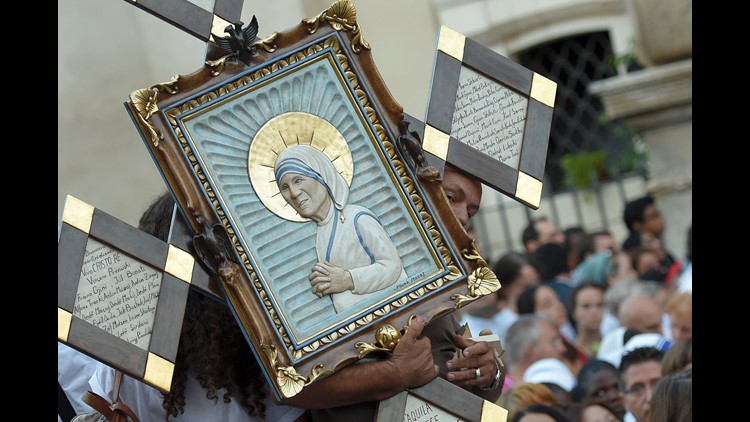ROME – Pope Francis declared Mother Teresa a saint on Sunday, honoring the tiny nun who cared for the world’s most destitute and holding her up as a model for a Catholic Church that goes to the peripheries to find poor, wounded souls.
Applause erupted in St. Peter’s Square even before Francis finished pronouncing the rite of canonization at the start of Mass, evidence of the admiration Mother Teresa enjoyed from Christians and non-Christians alike.
For Francis, Mother Teresa put into action his ideal of the church as a merciful “field hospital” for the poorest of the poor, those suffering both material and spiritual poverty. By canonizing her during his Jubilee Year of Mercy, he in some ways is making her the icon of his entire pontificate.
Hundreds of Missionaries of Charity sisters in their trademark blue-trimmed saris had front-row seats at the Mass, sitting under a searing hot sun and blue skies alongside 1,500 homeless people and 13 heads of state or government, including Queen Sofia of Spain.
“Her heart, she gave it to the world,” said Charlotte Samba, a 52-year-old mother of three who travelled with a church group from Gabon for the Mass. “Mercy, forgiveness, good works: It is the heart of a mother for the poor.”
While big, the crowds were not as large as the 300,000 who turned out for Mother Teresa’s 2003 beatification, thanks in part to security fears in the wake of Islamic extremist attacks in Europe. Those fears prompted a huge, 3,000-strong law enforcement presence to secure the area around the Vatican and close the airspace above.
Nevertheless, those on hand were jubilant to have made the journey — nuns, priests, volunteers, pilgrims and tourists clutching the coveted 100,000 tickets issued for the Mass.
One group of 40 Indian nationals traveled from Macerata, Italy to honor a woman given India’s highest civilian and humanitarian awards for her work in the slums of Kolkata. Another group of 100 drove from Kosovo toting a banner that read: “Mother Teresa: Pray for Us.”
While Francis is clearly keen to hold Mother Teresa up as a model for her joyful dedication to society’s outcasts, he is also recognizing holiness in a nun who lived most of her adult life in spiritual agony sensing that God had abandoned her.
According to correspondence that came to light after she died in 1997, Mother Teresa experienced what the church calls a “dark night of the soul” — a period of spiritual doubt, despair and loneliness that many of the great mystics experienced. In Mother Teresa’s case, it lasted for nearly 50 years — an almost unheard of trial.
For the Rev. Brian Kolodiejchuk, the Canadian priest who spearheaded Mother Teresa’s saint-making campaign, the revelations were further confirmation of Mother Teresa’s heroic saintliness. He said that by canonizing her, Francis is recognizing that Mother Teresa not only shared the material poverty of the poor but the spiritual poverty of those who feel “unloved, unwanted, uncared for.”
“What she described as the greatest poverty in the world today (of feeling unloved) she herself was living in relationship with Jesus,” he said in an interview on the eve of the canonization.
Francis has in many ways modeled his papacy on Mother Teresa’s simple lifestyle and selfless service to the poor: He eschewed the Apostolic Palace for a hotel room, he has made welcoming migrants and the poor a hallmark and has fiercely denounced today’s “throwaway” culture that discards the unborn, the sick and the elderly with ease.
In keeping with her spirit, he was treating 1,500 homeless people bussed into Rome for the Mass to a pizza lunch in the Vatican auditorium afterward.
Sunday’s festivities honoring Mother Teresa weren’t limited to Rome: In Kolkata, where she spent a lifetime dedicated to the poor, a special Sunday Mass was held at the order’s Mother House. Volunteers and admirers converged on Mother House to watch the canonization ceremony, which was being broadcast on giant TV screens in Kolkata and elsewhere.
Sisters of Charity volunteers planned to distribute food to the poor nearby after the ceremony, and community meals were being served across Catholic parishes in India on Sunday — a symbolic reference to Mother Teresa’s lifetime of service to humanity, said the Rev. Savarimuthu Sankar of the archdiocese of New Delhi.
“Let the example of Mother Teresa inspire all of us to dedicate ourselves to the welfare of mankind,” said Indian President Pranab Mukherjee.
Ceremonies were also expected in Skopje, Macedonia, where Mother Teresa was born, and also in Albania and Kosovo, where people of her same ethnic Albanian background live.
Born Agnes Gonxhe Bojaxhiu on Aug. 26, 1910, Mother Teresa came to India in 1929 as a sister of the Loreto order. In 1946, she received what she described as a “call within a call” to found a new order dedicated to caring for the most unloved and unwanted, the “poorest of the poor.”
In 1950 she founded the Missionaries of Charity, which went onto become a global order of nuns — identified by their trademark blue-trimmed saris — as well as priests, brothers and lay co-workers.
She was awarded the Nobel Peace Prize in 1979.
She died in 1997 after a lifetime spent caring for hundreds of thousands of destitute and homeless poor in Kolkata, for which she came to be called the “saint of the gutters.”
St. John Paul II, her most ardent supporter, fast-tracked her for sainthood and beatified her before a crowd of 300,000 in 2003.



